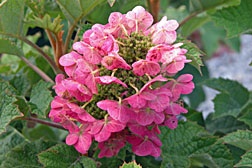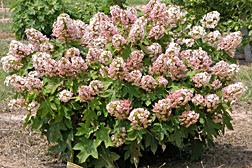
Features
Crops
Flowers
New Hydrangeas for landscape gardens
April 27, 2010 By By Stephanie Yao ARS News Service of USDA
April 27, 2010, McMinnville, TN – Two
new compact oakleaf hydrangea cultivars ideal for small gardens have
been
released by Agricultural Research Service (ARS) scientists.
April 27, 2010, McMinnville, TN – Two
new compact oakleaf hydrangea cultivars ideal for small gardens have been
released by Agricultural Research Service (ARS) scientists.
'Ruby
Slippers' and 'Munchkin' are the latest cultivars released by ARS geneticist
Sandy Reed with the U.S. National Arboretum’s Floral and Nursery Plants
Research Unit’s worksite in McMinnville, Tenn. The arboretum is operated by
ARS, the principal intramural scientific research agency of the U.S. Department
of Agriculture (USDA) .

|
| 'Ruby Slippers' PHOTOS COURTESY SANDY REED |
The
new cultivars are the first compact forms of Hydrangea quercifolia, a species
of hydrangea native to the southeastern United States, to be released by ARS.
H. quercifolia is commonly known as oakleaf hydrangea because its leaves
resemble those from oak trees. According to Reed, currently available oakleaf
hydrangea cultivars are taller than desired for small landscape gardens or, if
shorter, don’t have good flowering qualities.
'Ruby
Slippers' and 'Munchkin' address both of these issues. The new cultivars are small
in stature and have large flower heads that stay upright, even after heavy
rains. They grow 3-4 feet tall and 4-5 feet wide after nine years of growth,
with flower heads held upright above their leaves, making them particularly
suited for use in small residential landscapes. Flowers on 'Ruby Slippers' open
white but quickly turn pale pink and deepen into rose, while those on Munchkin
open white and gradually turn medium pink. Both plants flower in early summer.

|
| 'Munchkin' |
Like
other oakleaf hydrangeas, 'Ruby Slippers' and 'Munchkin' can be grown in full sun
or light shade and are hardy in USDA zones 5 to 8. They can be used in shrub
borders or mass-planted in large areas. The plants have been evaluated by
co-operators throughout the United States, and co-operators are currently
increasing stock. Reed anticipates the plants will be widely available for sale
to consumers in the next year or two.
Nursery
crops are a multi-billion dollar industry. Wholesalers in 17 states surveyed by
the USDA’s National Agricultural Statistics Service grossed $4.65 billion in
sales in 2006, the last year for which figures are available. That’s an
increase of 17 per cent from 2003 sales. Deciduous shrubs like the oakleaf
hydrangea accounted for 14 per cent of the industry’s total sales in 2006.
Stephanie Yao is an ARS communications specialist.
Print this page